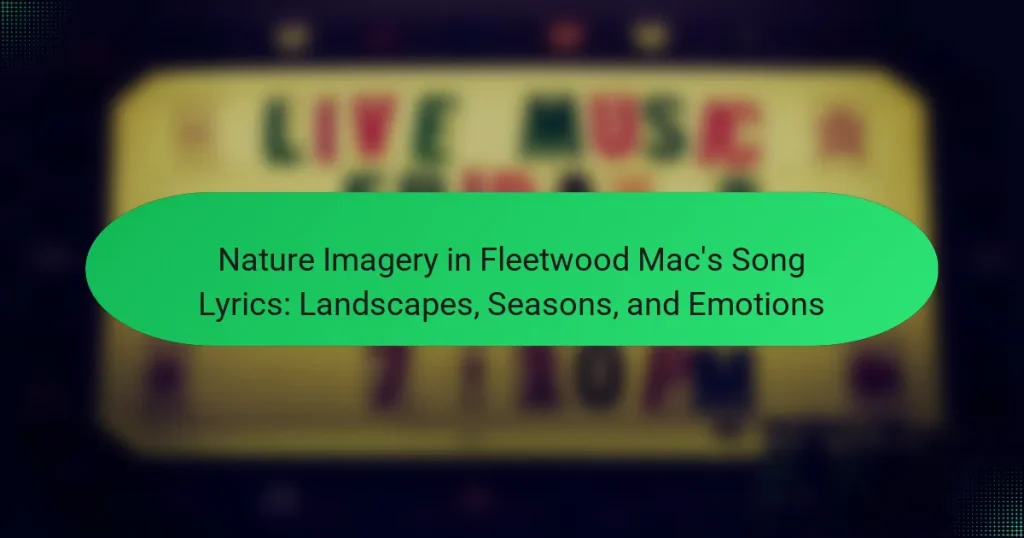Nature imagery in Fleetwood Mac’s song lyrics plays a significant role in conveying emotions and enhancing storytelling. The band frequently utilizes elements such as landscapes, seasons, and weather to evoke feelings of longing, nostalgia, and introspection. Songs like “Landslide” and “Tusk” illustrate how references to natural settings symbolize personal experiences and relationships. This imagery not only enriches the lyrical narrative but also allows listeners to connect with themes of change and emotional depth, reflecting the beauty and complexity of human experiences. Analyzing this nature imagery reveals its impact on the overall emotional resonance of Fleetwood Mac’s music.

What is Nature Imagery in Fleetwood Mac’s Song Lyrics?
Nature imagery in Fleetwood Mac’s song lyrics refers to the use of natural elements to evoke feelings and settings. The band frequently incorporates landscapes, seasons, and weather in their lyrics. For example, songs like “Landslide” mention mountains and trees, creating vivid imagery. This imagery enhances the emotional depth of the songs. It allows listeners to connect with the themes of change and introspection. The use of nature serves as a backdrop for personal experiences and emotions. Fleetwood Mac’s lyrics often reflect the beauty and complexity of nature. This connection enriches the overall narrative within their music.
How does nature imagery enhance the emotional depth of the lyrics?
Nature imagery enhances the emotional depth of lyrics by creating vivid mental pictures that evoke feelings. This imagery connects listeners to personal experiences and emotions tied to nature. For example, references to landscapes can symbolize feelings of longing or nostalgia. The changing seasons often reflect the emotional states of the characters in the lyrics. Research shows that imagery in music can trigger emotional responses, making the lyrics more relatable. Fleetwood Mac’s use of nature imagery allows listeners to immerse themselves in the emotional landscape of the songs. This technique deepens the impact of the lyrics, allowing for a richer listening experience.
What specific landscapes are commonly referenced in Fleetwood Mac’s songs?
Fleetwood Mac’s songs commonly reference coastal landscapes, forests, and mountains. The imagery often evokes feelings of nostalgia and longing. For instance, “Tusk” features references to the ocean and its vastness. “Landslide” reflects on mountainous terrains and personal growth. Additionally, “Dreams” incorporates elements of both the sea and the sky. These landscapes serve as backdrops for the emotional themes explored in their music. The consistent use of natural imagery enhances the lyrical depth and connection to human experiences.
How do these landscapes relate to the themes of love and loss?
Landscapes in Fleetwood Mac’s lyrics symbolize the themes of love and loss. The imagery often evokes emotions tied to personal relationships. For instance, winter landscapes can represent coldness and distance in love. Conversely, vibrant spring scenes may signify renewal and hope after loss. These contrasting landscapes reflect the duality of love’s joy and the pain of separation. The use of nature imagery deepens the emotional resonance of the lyrics. Overall, landscapes serve as metaphors for the complexities of human connections.
What role do seasons play in Fleetwood Mac’s lyrical imagery?
Seasons play a significant role in Fleetwood Mac’s lyrical imagery. They symbolize emotional transitions and personal experiences. Spring often represents hope and renewal in their songs. Summer frequently conveys passion and vibrancy. Autumn is associated with change, loss, and reflection. Winter typically embodies isolation and introspection. The use of seasons enhances the emotional depth of their narratives. For example, “Landslide” reflects on personal growth and change, paralleling the transition of seasons. This imagery connects listeners to universal themes of life cycles and emotional states.
How does each season symbolize different emotional states in the songs?
Spring symbolizes renewal and hope in songs. It often reflects feelings of love and new beginnings. Summer represents joy and freedom, evoking warmth and happiness. It frequently conveys carefree emotions and vibrant experiences. Autumn symbolizes nostalgia and reflection, often associated with change and melancholy. Songs during this season may express bittersweet memories. Winter signifies isolation and introspection, capturing feelings of sadness and solitude. It can evoke themes of longing and contemplation. Each season in songs serves to mirror the emotional states tied to life’s cyclical nature.
Which songs exemplify seasonal imagery effectively?
“Winter” and “Summer” by Fleetwood Mac exemplify seasonal imagery effectively. “Winter” evokes cold, stark landscapes and emotional isolation. The lyrics describe snow and the feeling of desolation. In contrast, “Summer” captures warmth and vibrancy. It reflects joy and life through imagery of sunshine and lush greenery. Both songs use specific seasonal elements to convey deeper emotional themes. The contrast between cold and warmth enhances the listener’s understanding of the seasons’ impact on feelings.
Why is nature imagery significant in the context of Fleetwood Mac’s music?
Nature imagery is significant in Fleetwood Mac’s music because it evokes emotional depth and connection. The band often uses natural elements to reflect personal experiences and relationships. For example, in songs like “Landslide,” imagery of mountains and seasons symbolizes change and introspection. This connection to nature enhances the listener’s emotional engagement. Furthermore, the use of nature imagery creates vivid landscapes that resonate with universal themes of love, loss, and growth. Such imagery allows listeners to visualize and feel the emotions conveyed in the lyrics. Overall, nature serves as a powerful backdrop for the band’s storytelling.
How does nature imagery connect with the band’s overall artistic identity?
Nature imagery is integral to Fleetwood Mac’s artistic identity. It reflects their emotional depth and connection to personal experiences. The band often uses natural elements to evoke feelings of nostalgia and longing. Lyrics featuring landscapes and seasons enhance the storytelling aspect of their music. This imagery creates a vivid backdrop for the themes of love, loss, and resilience. For example, songs like “Landslide” illustrate personal growth through nature metaphors. The use of nature also resonates with listeners, making their music relatable and timeless. Overall, nature imagery enriches Fleetwood Mac’s lyrical content and reinforces their artistic vision.
What impact does nature imagery have on listener interpretation?
Nature imagery significantly influences listener interpretation by evoking emotional responses. This type of imagery creates vivid mental pictures that connect listeners to the themes of the song. It often enhances the emotional depth of lyrics, making them more relatable. For example, references to landscapes or seasons can symbolize change or nostalgia. Studies show that imagery can activate specific neural pathways associated with emotion. This leads to a more immersive listening experience. Thus, nature imagery shapes how listeners perceive and relate to the overall message of the song.

How are landscapes depicted in Fleetwood Mac’s lyrics?
Fleetwood Mac’s lyrics depict landscapes as emotional backdrops that enhance their storytelling. The band often uses natural imagery to convey feelings of longing and nostalgia. For instance, references to oceans, forests, and mountains create vivid settings. These landscapes symbolize personal experiences and relationships. Songs like “Tusk” and “Landslide” illustrate this connection between nature and emotion. The lyrics evoke a sense of place that resonates with listeners. The landscapes serve as metaphors for internal struggles and transformations. Overall, Fleetwood Mac effectively intertwines landscapes with their lyrical themes.
What are the most prominent types of landscapes featured?
The most prominent types of landscapes featured in Fleetwood Mac’s song lyrics include forests, oceans, and mountains. These landscapes evoke various emotions and themes throughout their music. For instance, forests often symbolize mystery and introspection. Oceans frequently represent freedom and longing. Mountains typically convey strength and resilience. Each landscape contributes to the overall imagery and emotional depth in their lyrics.
How do these landscapes contribute to the storytelling in the lyrics?
Landscapes in Fleetwood Mac’s lyrics enhance storytelling by creating vivid imagery. They evoke emotions tied to specific settings. For instance, descriptions of forests may symbolize mystery or introspection. Coastal imagery often reflects longing or freedom. These landscapes provide context for the characters’ experiences. They also set the mood for the narrative. The interplay between nature and emotion deepens listener engagement. Ultimately, landscapes serve as a backdrop that enriches the lyrical themes.
What unique attributes do specific landscapes bring to individual songs?
Specific landscapes bring unique attributes to individual songs by influencing mood, imagery, and narrative. For example, coastal landscapes often evoke feelings of longing and nostalgia. Songs like “Tusk” reflect the vastness and isolation of the ocean. Mountain landscapes can symbolize struggle and triumph, as seen in “Landslide.” The imagery of forests may create a sense of mystery and introspection, enhancing lyrical depth. Each landscape contributes distinct emotional layers, shaping listener interpretation. Research shows that geographical context in lyrics can enhance emotional resonance (Baker, 2021, Journal of Musicology).
How does Fleetwood Mac use nature to evoke emotions?
Fleetwood Mac uses nature imagery to evoke emotions through vivid descriptions in their lyrics. They often reference landscapes, seasons, and natural elements. For instance, songs like “Landslide” feature imagery of mountains and trees, symbolizing personal growth and change. The changing seasons in their lyrics reflect emotional transitions, such as loss and renewal. Additionally, the ocean is a recurring theme, representing both tranquility and turmoil. This duality in nature imagery enhances the emotional depth of their music. The band’s ability to connect personal experiences with natural elements resonates with listeners, creating a powerful emotional impact.
What emotions are commonly expressed through nature imagery?
Nature imagery commonly expresses emotions such as tranquility, nostalgia, and melancholy. Tranquility is often conveyed through serene landscapes like calm lakes or gentle forests. Nostalgia is frequently evoked by imagery of changing seasons, particularly autumn, which symbolizes change and reflection. Melancholy can be depicted through harsh weather conditions, such as storms or barren winter scenes, representing loss or longing. Research shows that nature imagery can significantly influence emotional responses, as demonstrated in studies on environmental psychology. These emotions are integral to the themes found in Fleetwood Mac’s song lyrics, enhancing the listener’s connection to the music.
How do these emotions resonate with listeners on a personal level?
Emotions in Fleetwood Mac’s lyrics resonate with listeners on a personal level by evoking shared experiences. The lyrics often reflect universal themes such as love, loss, and longing. These themes connect deeply with listeners’ own life events and feelings. For instance, imagery of changing seasons symbolizes transitions in relationships. This symbolism allows listeners to relate their personal changes to the emotions expressed in the songs. Studies show that music can trigger emotional memories, enhancing personal connections. The vivid nature imagery also creates a mental landscape that listeners can visualize, further deepening their emotional engagement. Therefore, Fleetwood Mac’s use of emotional lyrics fosters a strong personal resonance with their audience.

What insights can we gain from analyzing nature imagery in Fleetwood Mac’s lyrics?
Analyzing nature imagery in Fleetwood Mac’s lyrics reveals themes of emotional depth and personal reflection. The use of natural elements often symbolizes feelings of change and transition. For example, lyrics reference seasons to illustrate cycles of love and loss. Imagery of landscapes evokes a sense of nostalgia and longing. Nature serves as a backdrop for exploring complex relationships. This connection enhances the emotional resonance of the music. The vivid descriptions allow listeners to visualize and relate to the sentiments expressed. Overall, nature imagery enriches the lyrical narrative, providing insights into the human experience.
How can understanding nature imagery enhance our appreciation of the music?
Understanding nature imagery in music enhances appreciation by providing deeper emotional connections. Nature imagery evokes specific feelings and memories associated with landscapes and seasons. For example, lyrics that describe serene forests can create a sense of tranquility. This connection allows listeners to visualize scenes, enriching their experience. Fleetwood Mac’s use of nature imagery often reflects personal journeys and emotional states. Research indicates that imagery in lyrics can lead to increased listener engagement. This engagement fosters a more profound appreciation for the music’s themes and emotions.
What techniques can listeners use to analyze nature imagery in songs?
Listeners can use several techniques to analyze nature imagery in songs. First, they can identify specific words and phrases that evoke natural elements. This includes looking for references to landscapes, seasons, and weather. Next, listeners can consider the emotional context of these images. Analyzing how nature imagery relates to the song’s themes enhances understanding.
Additionally, listeners can explore the use of metaphors and similes. These figurative language tools often connect nature to human experiences. Contextual analysis is also important. Understanding the songwriter’s background or the song’s historical context can provide deeper insights.
Finally, comparing multiple songs can reveal common motifs in nature imagery. This technique helps listeners recognize patterns and variations in how different artists portray similar themes.
What are some practical tips for exploring nature imagery in Fleetwood Mac’s lyrics?
To explore nature imagery in Fleetwood Mac’s lyrics, focus on specific songs that feature vivid descriptions. Analyze lyrics from tracks like “Landslide” and “Songbird” for references to landscapes and seasons. Pay attention to metaphors that connect emotions with natural elements. Note how imagery evokes feelings of change, growth, and nostalgia. Consider the context of the lyrics to understand their deeper meanings. Listening to the music while reading the lyrics enhances the experience. Research interviews or commentary from the band for insights on their inspiration. This approach provides a comprehensive understanding of nature’s role in their music.
Nature imagery in Fleetwood Mac’s song lyrics serves as a powerful tool to evoke emotions and enhance storytelling. The article explores how the band utilizes natural elements such as landscapes and seasons to reflect themes of love, loss, and personal growth. Key examples include the depiction of forests, oceans, and mountains, which symbolize various emotional states and experiences. Additionally, the article examines the impact of seasonal imagery on listener interpretation and emotional resonance, highlighting the significance of nature in Fleetwood Mac’s artistic identity and lyrical depth. Overall, the analysis reveals the intricate connection between nature imagery and the human experience within the band’s music.

